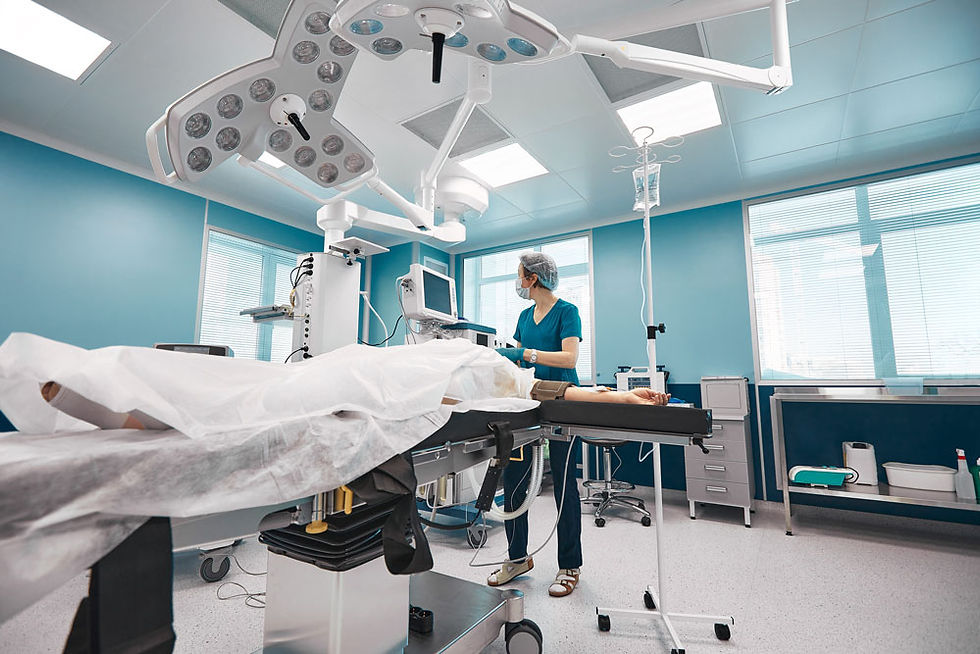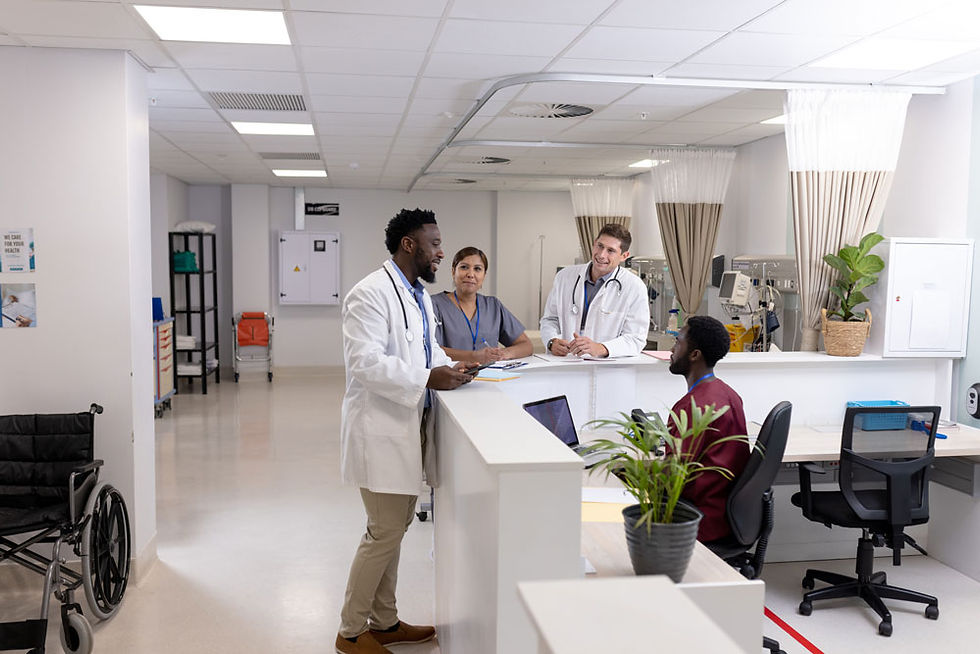How Norfolk's Medical Facilities Stay Comfortable and Compliant
- Claire Jaramillo
- Aug 23
- 4 min read
Norfolk's medical corridor along Colley Avenue and throughout the Ghent area serves thousands of patients daily. Behind the scenes of every comfortable doctor's office, urgent care center, and medical facility is an HVAC system working under some of the most demanding conditions in commercial heating and cooling.
Medical facilities can't just be "comfortable enough." They have strict requirements for temperature control, humidity levels, and air quality that go far beyond typical commercial spaces. Here's what every Norfolk medical facility manager needs to know, so their medical facilities stay comfortable and compliant.

Why Medical HVAC Is Different from Other Commercial Systems
Patient Comfort Equals Patient Satisfaction: Uncomfortable patients are stressed patients. Stressed patients give lower satisfaction scores, leave negative reviews, and may avoid returning for necessary care. Your HVAC system directly impacts your practice's reputation and success.
Regulatory Compliance Requirements: Medical facilities must maintain specific temperature and humidity ranges as required by state health departments and accreditation bodies. Failure to maintain these conditions can result in citations, fines, or worse – threats to patient safety.
Infection Control: Proper ventilation and air filtration help prevent the spread of airborne pathogens. This became critically important during COVID-19, but it's always been essential for protecting vulnerable patients.
Equipment Protection: Medical equipment worth hundreds of thousands of dollars requires stable environmental conditions. Temperature and humidity fluctuations can damage sensitive diagnostic and treatment equipment.
Norfolk's Unique Medical HVAC Challenges
Historic Building Integration: Many Norfolk medical practices operate in converted historic buildings along Colley Avenue and in Ghent. These beautiful spaces weren't designed for modern HVAC systems or medical facility requirements.
Humidity from the Bay: Norfolk's proximity to the Chesapeake Bay creates year-round humidity challenges that can promote mold growth and affect air quality – critical concerns in healthcare settings.
Multiple Use Zones: Medical facilities need different environmental conditions in different areas:
Waiting rooms: Comfortable for all ages and health conditions
Exam rooms: Precise temperature control for patient comfort during examinations
Procedure rooms: Specific conditions for various medical procedures
Medication storage: Strict temperature and humidity requirements
Staff areas: Comfortable working conditions for long shifts
Temperature and Humidity Requirements for Medical Facilities
General Patient Areas:
Temperature: 70-75°F
Humidity: 30-60% relative humidity
Air changes per hour: Minimum 6 (higher for certain procedures)
Procedure Rooms:
Temperature: 68-73°F (depending on procedure type)
Humidity: 30-60% relative humidity
Positive air pressure to prevent contamination
Medication Storage:
Temperature: Varies by medication (often 68-77°F)
Humidity: Controlled to prevent degradation
Consistent conditions 24/7
Patient Recovery Areas:
Temperature: 70-75°F
Draft-free environment
Quiet operation essential
Common HVAC Problems in Norfolk Medical Facilities
Insufficient Humidity Control: Standard commercial systems often can't maintain the precise humidity levels medical facilities require, especially during Norfolk's humid summers.
Poor Air Distribution: Converted spaces may have inadequate ductwork design, creating hot/cold spots that make patients and staff uncomfortable.
Inadequate Filtration: Medical facilities need higher-grade air filtration than typical commercial spaces to protect vulnerable patients.
System Reliability Issues: When a restaurant's AC fails, it's inconvenient. When a medical facility's HVAC fails, it can force cancellation of procedures and put patients at risk.
Noise Issues: Medical facilities require quiet operation so patients can rest and staff can communicate effectively.
The Air Handlers Medical Facility Advantage
Medical-Specific Experience: We've designed and maintained HVAC systems for Norfolk medical facilities for over 30 years. We understand the unique requirements and regulations.
5-Year Warranty Protection: Medical facilities can't afford HVAC failures. Our 5-year commercial warranty provides the reliability and peace of mind healthcare providers need.
Emergency Response: Medical facilities get priority emergency service because we understand that HVAC failures in healthcare settings aren't just uncomfortable – they can be dangerous.
Compliance Documentation: We provide the documentation medical facilities need for regulatory compliance and accreditation requirements.
Case Study: Norfolk Urgent Care Success Story
A Norfolk urgent care center in a converted historic building was struggling with humidity control and patient complaints about comfort. Their existing system couldn't maintain consistent conditions between the waiting room, exam rooms, and procedure areas.
The Challenge:
Historic building with limited renovation options
Need for precise temperature control in multiple zones
Humidity levels that met health department requirements
Quiet operation for patient comfort
Our Solution:
Multi-zone system with individual room control
Enhanced dehumidification capability
Medical-grade air filtration
Sound-dampened equipment selection
Results:
Patient satisfaction scores improved 35%
No more regulatory compliance issues
25% reduction in energy costs
Staff comfort complaints eliminated

Preventive Maintenance for Medical Facilities
Medical facilities need more frequent maintenance than typical commercial spaces:
Monthly: Air filter inspection and replacement as needed Quarterly: System performance verification and documentation Bi-annually: Complete system inspection and calibration Annually: Comprehensive system evaluation and regulatory compliance review
Planning for Medical Facility HVAC Upgrades
Growth Considerations: Many Norfolk medical practices are expanding. Your HVAC system should be designed to accommodate future growth without complete replacement.
Technology Integration: Modern medical equipment affects HVAC loads differently than older equipment. System designs must account for current and planned equipment additions.
Energy Efficiency: Medical facilities operate longer hours than most commercial spaces. Energy-efficient systems provide significant long-term savings.
Backup Systems: Consider redundancy for critical areas to ensure continuous operation even during maintenance or equipment failures.
Choosing an HVAC Partner for Your Medical Facility
Not all commercial HVAC companies understand medical facility requirements. When selecting an HVAC partner, ensure they:
✓ Have specific medical facility experience
✓ Understand regulatory compliance requirements
✓ Provide comprehensive warranty protection
✓ Offer priority emergency service
✓ Can provide compliance documentation
✓ Have local presence for reliable service
Your Patients Deserve Optimal Comfort
Your medical facility's HVAC system is more than just heating and cooling – it's a critical component of patient care, regulatory compliance, and practice success.
Is your Norfolk medical facility's HVAC system meeting all your needs? Contact Air Handlers at 757-734-7171 for a comprehensive medical facility HVAC assessment. We understand healthcare requirements and provide the reliability your patients deserve.




Comments